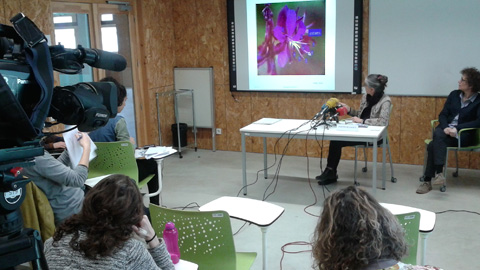High levels of pollen expected this spring

07/03/2017
Spring pollinations have begun quite punctually (some years it comes earlier) and the levels are very high, surpassing in many cases the historical maximums registered from 1994. These past years reveal that the extreme mildness of daytime temperatures has a greater effect than the cold evenings and nights with regard to the maturing of pollen in plants and the beginning of pollination.
The intensity of the pollination is related to water availability, and the amount of summer and autumn rainfall has been enough to generate an important number of bloom. As the coordinator of the Aerobiological Network of Catalonia Jordina Belmonte said at a press conference: “It is going to be a difficult spring”. Belmonte is also director of the Institute of Environmental Science and Technology (ICTA-UAB) and lecturer of the Department of Animal Biology, Plant Biology and Ecology.
Belmonte explained that “we predict important amount of pollen for this spring, especially of species such as plan trees, parietaria and gramineae, which are quite aggressive” and in cities such as Barcelona “50% of the pollen is produced by plane trees”.
When pollinations coincide with rain they are affected because the raindrops drag the pollen and flowers to the ground. This has clearly happened with the pollen from cypresses, hazelnut trees, ash, poplar and elm, which has decreased drastically this year with the winter rains. Normally, when this happens pollinations occur during a shorter period of time and the pollen gathered is less than what is generated.
However, the same rain that cleans the air of pollen (as well as the snow in the mountains when it melts) will serve to water plants which further on will produce more pollen, and therefore pollination in the spring and summer can be important among species such as parietaria, gramineae, plantago major, goosefoot, olive, etc.
Is there anything which could change these predictions, which seem worrying for individuals with allergies? Yes, everything could change if there is much rain in the spring (current models point to that not being the case) and also if the temperatures rapidly rise higher than expected (this seems more probable). That would make the flowering and pollination period last less than usual and therefore affect people with allergies less.
Allergic Pathologies
The President of the Catalan Society for Allergy & Clinical Immunology (SCAIC) Teresa Dordal explained at the presentation that “one and a half million people suffer from some respiratory allergy, which in 4 out of every 10 cases is caused by pollen”. Considering that this is the first cause of rhinitis and the second cause of asthma, the quantification of pollen grains in the atmosphere "is of vital importance to design therapeutic and prevention strategies for each allergy patient”.
Despite there being less amounts of pollen in cities than in rural areas, respiratory allergies are on the rise. Air pollution and ornamental uses of allergenic species seem to explain this situation, given that "diesel particle emissions produced by cars and heating devices are able to modify the characteristics of the pollen, causing them to be even more allergenic", Dordal explains. In addition, climate change modifies the behaviour of plants and influences their periods of pollination. “Plants now pollinate for longer periods of time, and produce greater amounts of more aggressive pollen.”